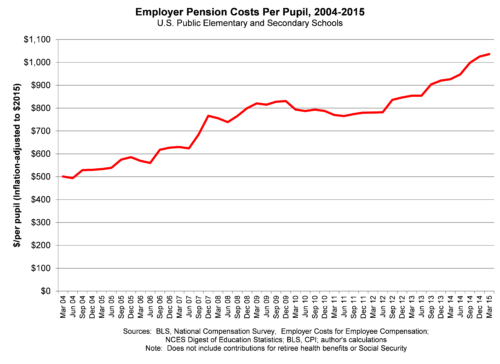
Newswire – April 3, 2018
CAUTION: This newswire contains serious and thought-provoking commentary on teacher pay and teacher strikes.
 IN LIGHT OF THE TEACHER STRIKES, we are compelled to bring you some facts, research and data about teacher pay that we hope will enlighten and inform readers and help you avoid simply falling into the trap of saying to yourself, “Oh wow, this is awful that we pay teachers so poorly…” Indeed, we do pay teachers poorly, and the pay scales and structures of how teachers are hired, rewarded, retained and paid later in retirement are completely broken. This is not an exhaustive analysis, just a smattering of thoughts that should propel you to do your research before jumping to conclusions.
IN LIGHT OF THE TEACHER STRIKES, we are compelled to bring you some facts, research and data about teacher pay that we hope will enlighten and inform readers and help you avoid simply falling into the trap of saying to yourself, “Oh wow, this is awful that we pay teachers so poorly…” Indeed, we do pay teachers poorly, and the pay scales and structures of how teachers are hired, rewarded, retained and paid later in retirement are completely broken. This is not an exhaustive analysis, just a smattering of thoughts that should propel you to do your research before jumping to conclusions.
MOST ARE OUTRAGED BY TEACHER PAY LEVELS. How bad are they, really? The answer is, It depends. Confirms the California education blog ED100: “It is difficult to accurately compare teacher pay with private sector pay, because they work differently. In a simple comparison, teacher salaries can seem worse than they are. Private-sector workers’ retirement dollars flow through paycheck deductions and build up in a way that is easy to count. They show up on a monthly statement. They accumulate in an account… Teacher pensions, by contrast, don’t accumulate. Like a life insurance contract, teacher pensions are a promise of future payments. The ‘payout’ on this contract varies mostly on how long the beneficiary lives.” Incidentally, that payout results in teachers being able to retire and earn nearly their full salary for every year of their lives afterward.
Then there are union dues, which can be another $600-$1,000 a year, with no obvious benefit other than to be told why your profession is underpaid and encouraged to strike… This why tens of thousands of teachers oppose these compulsory paycheck fees, teachers like California’s Rebecca Friedrichs who took her case to the Supreme Court and Illinois’ Mark Janus who is awaiting the High Court’s decision on his challenge (which will likely be handed down this June). (For background reading, see this op-ed by CER’s CEO, Jeanne Allen, and listen to this podcast with Mark Mix, president of the organization that represents Mark Janus.)
STRIKING FOR THE WRONG THING? The teacher unions won’t tell them, but the teachers who are striking across the country aren’t going to solve anything even if the legislatures give them an annual raise. Why such a strident statement? Consider the following number: $1,000 PER PUPIL. That’s the annual cost of employee pensions. Imagine a school of 600 students — that’s $600,000! Let’s just say half those funds could go to teachers instead of the state pension coffers upfront. There are approximately 26 classroom teachers in a school that size, if we are talking a traditionally organized school. If you took just half of those funds and put them in teachers’ salaries in that school, they’d be earning another $11,000 a year each! Please note that these funds are above and beyond employee contributions, Social Security and taxes.

LET’S TALK MORE ABOUT PENSIONS. As teachers retire they will need to access the pensions they were promised and which the state has paid into. Those funds are paid by the current crop of teachers, to the tune of ten percent of their earnings. Let’s take the average pay for an Oklahoma teacher — $50,000 (which is equivalent to about $76,000 in Stamford, Connecticut. For all you New York Times readers, the cost of living in the Northeast is between 40-60% higher). According to a study from the National Center for Analysis of Longitudinal Data in Education Research, “On average across state plans, over ten percent of current teachers’ earnings are being set aside to pay for previously accrued pension liabilities. This amounts to a large reduction in real operating spending per student. . . . A significant fraction of the resources allocated toward teacher compensation in current public education budgets is not being invested in resources to educate today’s students at all.”
WHAT TO DO? Researchers who have been studying this issue for years argue that there are several policy changes that could favor teachers while they work and reduce the pension burden that accumulates on states that are constantly threatened by shifting economic conditions: “(1) transition teachers to defined-contribution retirement plans, (2) transition teachers to cash-balance retirement plans, and (3) tighten the link between funding and benefit formulas within the current defined benefit structure.”
IF YOU REALLY WANT TO GET SMART on teacher pensions, you need to spend some time here. The solutions guiding what teachers make and what the state spends, on top of pension costs. There have been dramatic increases in the past ten years in public pension and benefit spending.
TIME TO RETHINK TEACHER PAY. We’re rethinking everything else — higher ed, K-12, workforce, school safety — so how about teaching? First, compensation is wildly uneven, being delivered to teachers through schools based on state rules governing experience and pay schedules that often see teachers meeting the peak of their salary years after most other professions, in their 50s! As respected researcher Marguerite Roza writes for the left-leaning Brookings Institution, “…a disproportionate amount of available salary funds is concentrated on teachers at the end of their career.”
“District leaders are steering a disproportionate share of the highly constrained public education funds toward a small segment of the teaching force — the group of teachers least likely to leave teaching. The National Center for Education Statistics Teacher Follow up Survey reports that while fewer than four percent of teachers with more than 20 years’ experience leave before retirement, 13.5 percent of teachers with under five years’ experience do. The lower turnover among senior teachers might be a result of the higher salaries, or of proximity to pension earnings — we don’t know for sure… But current distribution patterns leave few dollars for pay raises in a teacher’s earlier years where turnover is most acute.
“These practices not only result in lower salaries for most teachers, they also channel funds in ways that jeopardize equity across schools and create havoc for district financial stability.”
DID YOU KNOW?
“Most public-school teachers’ salaries are determined by years in the classroom and degrees held. But a new study from the Manhattan Institute shows that the premium we pay for teacher experience is far greater than is typically acknowledged.”

In Memory. Oh, Pat, you would have a field day with this newswire! A relentless data gatherer, truth seeker, amazing communicator and reporter, our dear friend and colleague Pat Korten (who we were able to lure out of retirement to help us with writing, editing and policy guidance, after having spent more than 30 years in the communications field), left us unexpectedly and far too soon last week. He would have edited this piece with depth and perfection, attributes he offered to us and to so many others in all his deeds. We will miss him, but know his abundant qualities are now being deployed by God.











